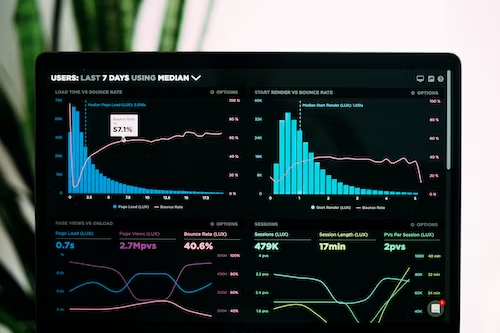Data visualization is a powerful tool to help organizations make better decisions. It allows us to take large amounts of data and break it down into easily digestible visuals that can be used to identify trends, spot potential opportunities, or uncover hidden insights. By leveraging the power of data visualization, businesses are able to make smarter decisions faster and with greater confidence. Let’s see how and why.

1. Data Visualization Helps Simplify Complex Information
One of the key benefits of data visualization is that it can take complex information and simplify it into accessible visuals. By making large amounts of data easier to understand, businesses are able to identify actionable insights quickly and easily. This also helps reduce decision-making time as well as enable more accurate decision-making. You could even take a data visualisation short course online that will help you understand the fundamentals. It’s a great way to become better informed and get ahead in the current business landscape.
2. Improved Accuracy in Decision Making
Another benefit of data visualization is that it leads to improved accuracy in decision-making. By breaking down complex data sets into visual representations, organizations are better able to decipher patterns and correlations which can lead to better decisions being made. Furthermore, visually representing data allows for a much clearer view of trends which enables business leaders to make decisions based on factual evidence. This helps reduce the risk of making wrong decisions and improves the likelihood of success in any given project or initiative.
3. Faster Response Time
Data visualization also enables businesses to respond faster to changes in their environment. By visually understanding data, organizations can quickly identify changes that may affect their operations and take action accordingly. This not only helps increase efficiency but also ensures that they are ahead of the potential competition as they are able to react more quickly to changes in the market. The faster response time enabled by data visualizations helps organizations stay ahead of their competition and remain successful. If you need help understanding data visualizations, it might be a good idea to get an online data visualization course.
4. Cost Savings
Next, data visualization can help organizations achieve cost savings. By quickly and accurately visualizing data, businesses are able to identify more efficient practices which may include automation or outsourcing. This reduces the amount of time and money spent on tasks that could be handled more efficiently elsewhere thus leading to cost savings for the organization. Additionally, data visualization can lead to improved customer service by allowing employees to better understand customer needs in order to provide a better experience.
5. More Informed Decisions
Also, data visualization enables organizations to make more informed decisions. By using visuals to understand the data, businesses are able to quickly identify correlations and spot trends which may not be immediately apparent when looking at raw data. This allows them to make more informed decisions based on factual evidence rather than intuition or opinion. Furthermore, it helps eliminate bias in decision-making as business leaders have access to all available information before making a decision.
6. Improved Storytelling
Data visualization can be used to improve storytelling. By visualizing data in an organized way, organizations are able to create compelling stories with their visuals which help them better communicate their message and engage audiences. This is particularly useful when making presentations or delivering reports as it helps keep viewers engaged and easier to understand the information being presented. It can also help organizations better explain their goals and objectives with visuals rather than text to convey a more powerful message.
7. Improved Understanding of Data
Finally, data visualization helps improve the understanding of data. By visually representing data sets, individuals are able to comprehend the information much easier than if they were looking at a spreadsheet or table. This makes it simpler for them to identify patterns and correlations which can be used to make better decisions. It also allows for easier comprehension of complex topics as visual representations are often more legible than text-based documents.
Is it hard to learn data visualization?
It can be difficult to learn data visualization due to its complexity but with an online course, it can be mastered in no time. By taking a data visualization course, you will gain the skills needed to create visuals that effectively communicate complex information and help make smarter decisions. With this knowledge, organizations can remain competitive and achieve better results. Knowing data visualization is the key to making smarter decisions and a worthwhile investment for any organization. It is an essential tool for any business looking to stay ahead of their competition.
Why is it important for businesses to use data visualization?
Data visualization is an important tool for businesses as it allows them to quickly understand complex data sets and spot trends that may not be immediately apparent. This helps organizations make better decisions faster, which in turn can lead to cost savings and improved customer service. Additionally, data visualizations enhance storytelling capabilities by making it easier to convey a powerful message while engaging viewers. Knowing how to create effective data visualizations is essential for any business looking to remain competitive and achieve success in today’s market.
How can data visualization help businesses make better decisions?
Data visualization can help businesses make better decisions by providing accurate representations of data that quickly and easily convey information. This allows decision-makers to identify correlations and spot trends more quickly which helps them make informed choices. Additionally, it eliminates bias in decision-making as business leaders have access to all available information before making a decision. Finally, it helps organizations create compelling stories with visuals that can engage audiences and help explain their goals and objectives more effectively than text-based documents.

Overall, it is clear that data visualization has multiple benefits which include improved accuracy in decision-making, faster response time, cost savings, more informed decisions, improved storytelling, and improved understanding of data. If you wish to learn about this topic further, consider taking up online courses like a data visualization short course which will help you understand the fundamentals of data visualization. By understanding data visualizations, you can make more efficient and smarter decisions for your business. Good luck!
















